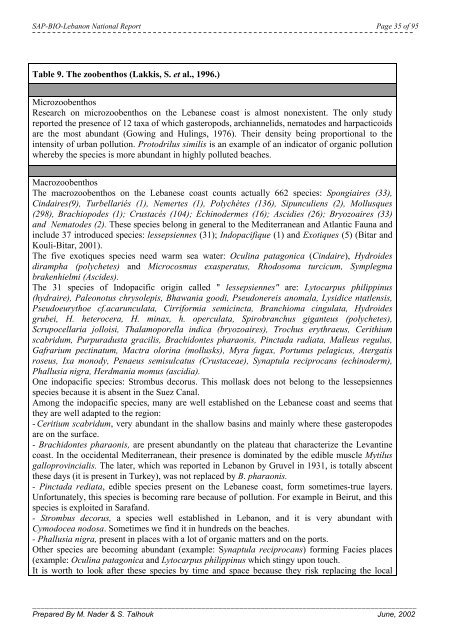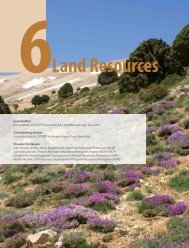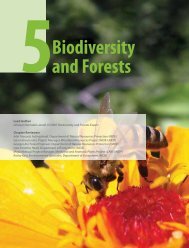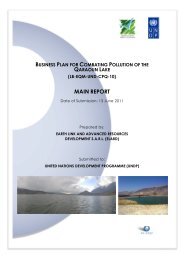Project for the preparation of a Strategic Action Plan for the ...
Project for the preparation of a Strategic Action Plan for the ...
Project for the preparation of a Strategic Action Plan for the ...
Create successful ePaper yourself
Turn your PDF publications into a flip-book with our unique Google optimized e-Paper software.
SAP-BIO-Lebanon National Report Page 35 <strong>of</strong> 95<br />
¯¯¯¯¯¯¯¯¯¯¯¯¯¯¯¯¯¯¯¯¯¯¯¯¯¯¯¯¯¯¯¯¯¯¯¯¯¯¯¯¯¯¯¯¯¯¯¯¯¯¯¯¯¯¯¯¯¯¯¯¯¯¯¯¯¯¯¯¯¯¯¯¯¯¯¯<br />
Table 9. The zoobenthos (Lakkis, S. et al., 1996.)<br />
Microzoobenthos<br />
Research on microzoobenthos on <strong>the</strong> Lebanese coast is almost nonexistent. The only study<br />
reported <strong>the</strong> presence <strong>of</strong> 12 taxa <strong>of</strong> which gasteropods, archiannelids, nematodes and harpacticoids<br />
are <strong>the</strong> most abundant (Gowing and Hulings, 1976). Their density being proportional to <strong>the</strong><br />
intensity <strong>of</strong> urban pollution. Protodrilus similis is an example <strong>of</strong> an indicator <strong>of</strong> organic pollution<br />
whereby <strong>the</strong> species is more abundant in highly polluted beaches.<br />
Macrozoobenthos<br />
The macrozoobenthos on <strong>the</strong> Lebanese coast counts actually 662 species: Spongiaires (33),<br />
Cindaires(9), Turbellariés (1), Nemertes (1), Polychètes (136), Sipunculiens (2), Mollusques<br />
(298), Brachiopodes (1); Crustacés (104); Echinodermes (16); Ascidies (26); Bryozoaires (33)<br />
and Nematodes (2). These species belong in general to <strong>the</strong> Mediterranean and Atlantic Fauna and<br />
include 37 introduced species: lessepsiennes (31); Indopacifique (1) and Exotiques (5) (Bitar and<br />
Kouli-Bitar, 2001).<br />
The five exotiques species need warm sea water: Oculina patagonica (Cindaire), Hydroides<br />
dirampha (polychetes) and Microcosmus exasperatus, Rhodosoma turcicum, Symplegma<br />
brakenhielmi (Ascides).<br />
The 31 species <strong>of</strong> Indopacific origin called " lessepsiennes" are: Lytocarpus philippinus<br />
(hydraire), Paleonotus chrysolepis, Bhawania goodi, Pseudonereis anomala, Lysidice ntatlensis,<br />
Pseudoeurythoe cf.acarunculata, Cirri<strong>for</strong>mia semicincta, Branchioma cingulata, Hydroides<br />
grubei, H. heterocera, H. minax, h. operculata, Spirobranchus giganteus (polychetes),<br />
Scrupocellaria jolloisi, Thalamoporella indica (bryozoaires), Trochus erythraeus, Cerithium<br />
scabridum, Purpuradusta gracilis, Brachidontes pharaonis, Pinctada radiata, Malleus regulus,<br />
Gafrarium pectinatum, Mactra olorina (mollusks), Myra fugax, Portunus pelagicus, Atergatis<br />
roseus, Ixa monody, Penaeus semisulcatus (Crustaceae), Synaptula reciprocans (echinoderm),<br />
Phallusia nigra, Herdmania momus (ascidia).<br />
One indopacific species: Strombus decorus. This mollask does not belong to <strong>the</strong> lessepsiennes<br />
species because it is absent in <strong>the</strong> Suez Canal.<br />
Among <strong>the</strong> indopacific species, many are well established on <strong>the</strong> Lebanese coast and seems that<br />
<strong>the</strong>y are well adapted to <strong>the</strong> region:<br />
- Ceritium scabridum, very abundant in <strong>the</strong> shallow basins and mainly where <strong>the</strong>se gasteropodes<br />
are on <strong>the</strong> surface.<br />
- Brachidontes pharaonis, are present abundantly on <strong>the</strong> plateau that characterize <strong>the</strong> Levantine<br />
coast. In <strong>the</strong> occidental Mediterranean, <strong>the</strong>ir presence is dominated by <strong>the</strong> edible muscle Mytilus<br />
galloprovincialis. The later, which was reported in Lebanon by Gruvel in 1931, is totally abscent<br />
<strong>the</strong>se days (it is present in Turkey), was not replaced by B. pharaonis.<br />
- Pinctada rediata, edible species present on <strong>the</strong> Lebanese coast, <strong>for</strong>m sometimes-true layers.<br />
Un<strong>for</strong>tunately, this species is becoming rare because <strong>of</strong> pollution. For example in Beirut, and this<br />
species is exploited in Sarafand.<br />
- Strombus decorus, a species well established in Lebanon, and it is very abundant with<br />
Cymodocea nodosa. Sometimes we find it in hundreds on <strong>the</strong> beaches.<br />
- Phallusia nigra, present in places with a lot <strong>of</strong> organic matters and on <strong>the</strong> ports.<br />
O<strong>the</strong>r species are becoming abundant (example: Synaptula reciprocans) <strong>for</strong>ming Facies places<br />
(example: Oculina patagonica and Lytocarpus philippinus which stingy upon touch.<br />
It is worth to look after <strong>the</strong>se species by time and space because <strong>the</strong>y risk replacing <strong>the</strong> local<br />
___________________________________________________________________________________________<br />
Prepared By M. Nader & S. Talhouk June, 2002





